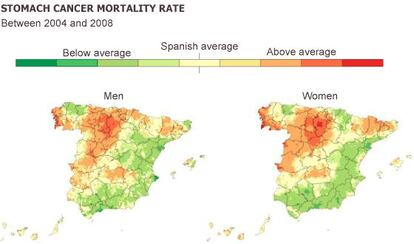Spain’s cancer map: how patients’ regions affect survival
Chart shows death rates from certain tumors can be up to 50% higher in some areas

Spanish scientists have produced the most detailed map to date showing mortality rates for six types of cancer throughout Spain – colon, stomach, bladder, breast, lung, and prostate. The findings reveal that in some areas, particularly where there is heavy industry, your chances of dying from the disease are 50 percent higher than the national average.
The map, produced by researchers from the National Epidemiology Center and published in the health journal BMC Cancer, is based on data relating to one million cancer deaths in Spain between 1989 and 2008. It shows, for example, that the risk of dying from stomach cancer is higher in Burgos and Palencia, in northern Spain’s interior, than anywhere else. Gonzalo López Abente, who has led the project, is wary of drawing conclusions, but suggests that diet could be a contributing factor: “These are areas where people eat a lot more cured and smoked meat, and less fruit and vegetables, than say, those living on the coast.”
Spanish Society for Epidemiology President Esteve Fernández says the health risks the map indicates are relative: “You can be three times at risk of dying from a certain type of cancer in one area, but the absolute risk is still minimal. Nobody should be moving to another area on the basis of the map. After all, smoking is more dangerous than where you happen to live.”

For example, the highest-risk areas for lung cancer in men are Extremadura and the western parts of Andalusia, Asturias and Cantabria. The highest rates for women are found in a few towns in Galicia.
Although lung cancer distribution is related to the number of smokers, the researchers say that air pollution is a big factor. In the case of Galicia, the cause seems to be radon, a radioactive gas produced by uranium decaying deep underground. The Health Ministry is now working on legislation to alert people about the dangers of radon.
Around 300,000 buildings in Spain have been identified as potentially having dangerous radon levels inside them, and there is now technology capable of removing it.
Mapping cancer rates over time is vital for tackling the illness, say the authors of the report: “The spatial distribution of death from tumors can reveal differences in the associated risk factors and contribute significantly to establishing policies to fight cancer,” the article says.
While López Abente says quick conclusions should not be drawn from the evidence the map suggests, previous surveys he has led show that people in communities close to open cast coal mines have a 9.7 percent higher risk of dying from colon cancer than the rest of the population, and are also 6.6 percent times more likely to die from lung cancer. In Spain, such mines are to be found in León, Palencia, Teruel, Ciudad Real and Córdoba.
López Abente’s team has also produced research showing that people in communities close to cement factories have a higher-than-average risk of dying from cancer. Women living in towns or villages within a 10-kilometer radius are 10 percent more likely to develop colon cancer, while men are seven percent more likely.
“The important thing about this map is that it is not a snapshot, but instead shows how things have developed over the last 20 years,” says Fernández. This has allowed the team to show how higher-than-average levels of breast cancer, for example, have spread from Catalonia and the Balearics to Andalusia, where women are now 10 percent more likely to develop breast tumors than in the rest of Spain.
Nobody should be moving to another area on the basis of the map. Smoking is more dangerous than where you live”
Previous maps by the team have measured Spain’s cancer mortality between 1978 and 1992, and from 1989 to 1998. Although 50 percent of the 77,000 deaths from bladder cancer between 1989 and 2008 could be attributed to smoking, it also emerged that workers in the paint, metals, rubber and leather industries were also at risk, along with truck drivers, possibly as a result of exposure to diesel motor emissions.
Men make up 82 percent of deaths from bladder cancer in Spain, most of which occurred in Cádiz, Seville and Huelva provinces, which have significant chemical industries. Bages, a town in central Catalonia, also showed high rates of bladder cancer.
Miquel Porta, a former president of the European Federation of Epidemiology and Chair of Public Health at Barcelona’s Hospital del Mar Institute of Medical Research, accuses the country’s health authorities of failing to promote better diet as a way of reducing cancer incidence. “Eating more fruit and vegetables reduces the risk of stomach cancer and should not be seen as a luxury. We need to raise awareness of the need for people to eat more healthy.”
The atlas shows that in the last five years surveyed, growing numbers of women living in cities are developing lung cancer, which the team puts down to a deadly combination of air pollution and smoking. Porta says this should send a warning to health authorities to take action. “If we see more lung cancer among women in cities, and we know that tobacco and air pollution interact, the answer is to act on tobacco and air pollution by creating more open spaces and green areas in cities,” he says.
“Cancer is not a lottery”
“This data reminds us that we need much more vigorous policies to protect health, and that society needs to demand this. These maps make it clear that cancer is not a lottery. When we vote, we need to be thinking about radon, about heavy industry, about vehicle emissions,” says epidemiologist Miquel Porta. Colon cancer caused 225,000 deaths between 1989 and 2008. Distribution throughout Spain is relatively homogeneous, although Porta highlights risk factors such as obesity, particularly among low income groups. “We are failing in our policies to combat obesity: this isn’t just about accepting that individuals make decisions about how they live and must accept the consequences. The Health Ministry needs to be more active in monitoring geographic trends and in implementing new policies.”
Tu suscripción se está usando en otro dispositivo
¿Quieres añadir otro usuario a tu suscripción?
Si continúas leyendo en este dispositivo, no se podrá leer en el otro.
FlechaTu suscripción se está usando en otro dispositivo y solo puedes acceder a EL PAÍS desde un dispositivo a la vez.
Si quieres compartir tu cuenta, cambia tu suscripción a la modalidad Premium, así podrás añadir otro usuario. Cada uno accederá con su propia cuenta de email, lo que os permitirá personalizar vuestra experiencia en EL PAÍS.
¿Tienes una suscripción de empresa? Accede aquí para contratar más cuentas.
En el caso de no saber quién está usando tu cuenta, te recomendamos cambiar tu contraseña aquí.
Si decides continuar compartiendo tu cuenta, este mensaje se mostrará en tu dispositivo y en el de la otra persona que está usando tu cuenta de forma indefinida, afectando a tu experiencia de lectura. Puedes consultar aquí los términos y condiciones de la suscripción digital.
More information
Últimas noticias
Venezuela hardens its ‘revolutionary state’ project amid pressure from Trump
Sydney Sweeney, the actress praised by Trump: ‘Women are up against what society wants them to be’
The Bolsonaro surname: An advantage or liability in Brazil’s 2026 presidential elections?
Raúl Rocha, from jet-setting with Miss Universe to arms trafficking and fuel theft
Most viewed
- Reinhard Genzel, Nobel laureate in physics: ‘One-minute videos will never give you the truth’
- Pablo Escobar’s hippos: A serious environmental problem, 40 years on
- Charles Dubouloz, mountaineering star, retires at 36 with a farewell tour inspired by Walter Bonatti
- Why we lost the habit of sleeping in two segments and how that changed our sense of time
- The fall of a prolific science journal exposes the billion-dollar profits of scientific publishing










































